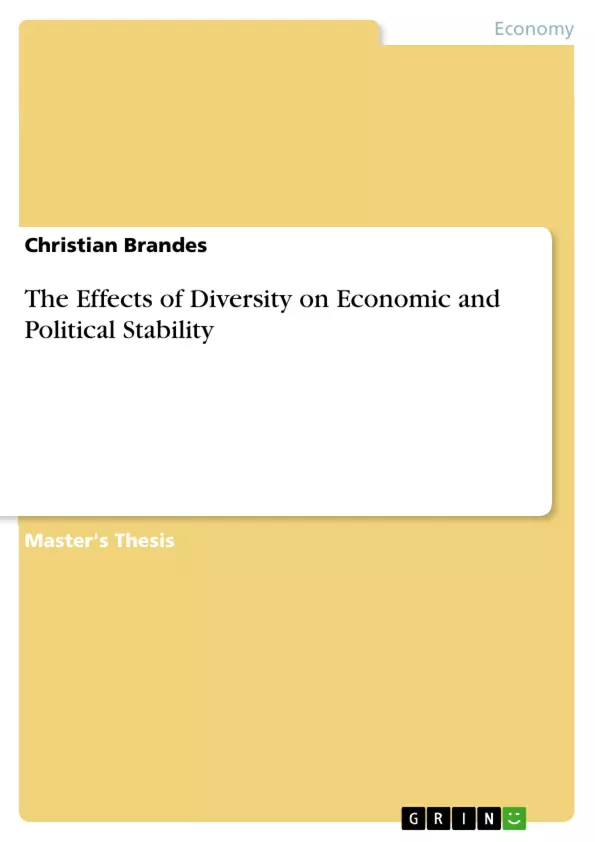Many developing countries do not only suffer from weak institutions, poor economic performance and corruption, but also from separatist movements and violent civil conflicts. The question arises why some countries could achieve economic growth and development, while others never experienced considerable economic development and are trapped in a vicious circle of re-occurring violent conflicts and economic deterioration. Since developing countries tend to be more diverse in terms of ethnicity, language and religion and many civil conflicts appear to have an ethnic or religious component, diversity is regarded as a main cause of economic and political instability. Furthermore, many scholars consider higher levels of diversity in the least developed countries to be the crucial factor that leads to inefficient policy decisions and impedes growth and development.
This master thesis addresses the question how diversity affects economic and political stability and elaborates appropriate parameters which are further used in a composite indicator (CI) to quantify a country’s stability, respectively instability. The thesis is structured as follows:
After a review of the literature on the relations between diversity and economic development and civil conflicts in chapter two, the historic and environmental conditions under which different ethnic and linguistic groups emerged are described. Further, the effects of external shocks which shaped ethnic development in the special case of Africa are assessed.
Chapter four introduces the most common measurements of ethnic, linguistic and religious diversity and describes the differences between fractionalisation and polarisation. Several studies describing the effects of different aspects of diversity on various economic and political outcomes are discussed.
This is followed by chapter five which is addressing the causes of instability and civil conflict. It is examined how conflict, as the major outcome of instability, is related to and can be driven by diversity and which roles economic and institutional aspects play in explaining civil conflicts.
In the subsequent part, several indicators which capture different aspects of stability are critically assessed. Further, parameters and their respective weights towards a new composite indicator of instability are elaborated. Subsequently, chapter seven concludes.
Table of Contents
- Introduction
- Literature Overview
- Historic Origins of Ethnic Diversity
- Emergence of Ethnic Variety
- The Slave Trades
- Colonisation and Border Drawing
- Economic Development and Governance in Diverse Societies
- Different Measures of Diversity
- Effects of Ethnic and Linguistic Diversity
- Effects of Religious Diversity
- Endogeneity and Dynamics of Diversity
- Effects of Social and Political Fragmentation
- Ethnic Voting and Favouritism
- Party System Fractionalisation
- Diversity and Stability
- Effects of Instability
- Influence of Diversity on Conflict
- Economic Causes of Civil Conflict
- Financial Opportunities of Civil Conflict
- Poverty and Inequality as Drivers of Instability
- The Role of Institutions in Civil Conflict and Instability
- Indices of Instability
- Assessment of Instability Indicators
- Towards a new Composite Indicator of Instability
Objectives and Key Themes
This master's thesis explores the complex relationship between ethnic, linguistic, and religious diversity and its influence on economic and political stability. It delves into the historical roots of diversity, examines its impact on economic development and governance, and investigates the link between diversity and instability, particularly in the context of civil conflict.
- The historical development and impact of ethnic, linguistic, and religious diversity.
- The relationship between diversity and economic development in diverse societies.
- The influence of diversity on political stability and the likelihood of civil conflict.
- The role of institutions in mitigating or exacerbating the effects of diversity on stability.
- Developing a composite indicator of instability that incorporates diverse factors.
Chapter Summaries
- Introduction: This chapter introduces the research topic, outlines the research objectives and key themes, and provides a brief overview of the thesis structure.
- Literature Overview: This chapter reviews existing literature on the topic of diversity and stability, highlighting key theoretical perspectives and empirical findings.
- Historic Origins of Ethnic Diversity: This chapter examines the historical processes that have shaped ethnic, linguistic, and religious diversity, including the emergence of ethnic variety, the slave trades, and the impact of colonialism.
- Economic Development and Governance in Diverse Societies: This chapter explores the relationship between diversity and economic development, examining different measures of diversity, the impact of ethnic and linguistic diversity, the effects of religious diversity, the role of endogeneity and dynamics, and the consequences of social and political fragmentation.
- Diversity and Stability: This chapter investigates the link between diversity and instability, focusing on the effects of instability, the influence of diversity on conflict, the economic causes of civil conflict, and the role of institutions in mitigating instability.
- Indices of Instability: This chapter explores various indices of instability, assesses their strengths and weaknesses, and proposes a new composite indicator that incorporates a broader range of factors.
Keywords
This research focuses on the key concepts of ethnic diversity, linguistic diversity, religious diversity, economic development, political stability, civil conflict, institutional quality, and instability. It explores the relationship between these concepts and examines their impact on societies.
- Arbeit zitieren
- Christian Brandes (Autor:in), 2017, The Effects of Diversity on Economic and Political Stability, München, GRIN Verlag, https://www.grin.com/document/431010



